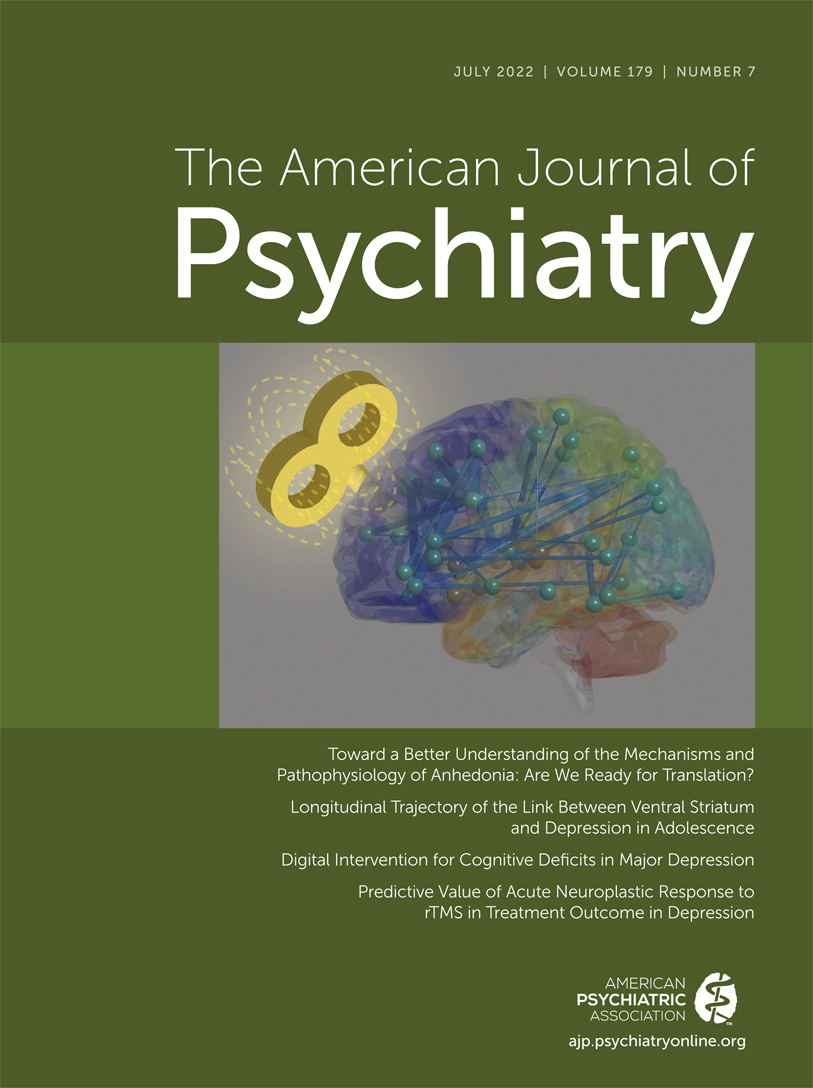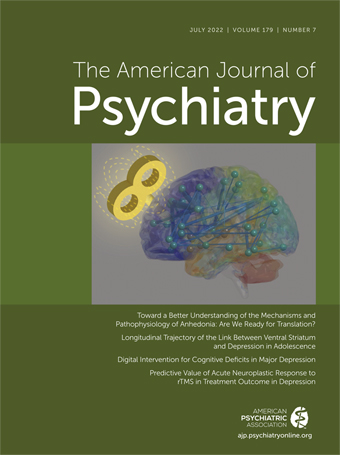Major depressive disorder is a common, impairing, costly illness that represents the leading cause of disability worldwide (
1). In 2020 in the United States, an estimated 14.8 million people age 18 or older (6% of all U.S. adults) and 2.9 million adolescents (12% of all U.S. adolescents) had at least one major depressive episode with severe impairment in the previous year (
https://www.nimh.nih.gov/health/statistics/major-depression). Selective serotonin reuptake inhibitors, which are considered the pillar of treatment for major depression, are highly effective in some individuals with depression, but only partially effective or ineffective in one-third to one-half of these patients (
2). Individuals who do not respond to antidepressants suffer from treatment-resistant depression. The 12-month prevalence of treatment-resistant depression is 2.76 million in the United States alone (
3). Thus, there is a strong need for effective treatment interventions in patients with major depressive disorder and treatment-resistant depression.
Efforts to develop novel antidepressant treatments in major depressive disorder and treatment-resistant depression have been challenging, partly because our understanding of depression pathophysiology and antidepressant mechanisms is still in its early stages. The monoamine hypothesis of depression neurobiology, which emphasizes the role of neurochemical deficits in patients with major depression (
4) and of increasing serotonergic, dopaminergic, and noradrenergic signaling to obtain an antidepressant response (
4), has shown some clear limitations. For example, research findings have demonstrated that rapid changes in serotonin and noradrenaline signaling do not produce rapid antidepressant effects. Additionally, clinical observations indicate that symptom presentation and response to antidepressant medications may vary greatly among individuals with major depressive disorder.
These observations have led to alternative conceptualizations in which depression is understood to arise from altered activity within neural circuits of specific brain networks (
5). In these circuit-based models, antidepressant effects are obtained by inducing plastic changes in neuronal populations, enhancing synaptic connectivity within and between these populations, and ameliorating or restoring the functional properties of specific neural circuits underlying depression-related behaviors and symptoms (
6). Transcranial magnetic stimulation (TMS) is a noninvasive brain stimulation technique uniquely equipped to modulate neural systems and related cognitive, affective, and behavioral functions in humans (
7). When applied in repetitive patterns (rTMS), this technique can induce plastic changes both in the cortical region directly targeted (e.g., the dorsolateral prefrontal cortex [DLPFC]) and in regions anatomically and functionally connected to this cortical area trans-synaptically (
7). Furthermore, after being initially approved by the U.S. Food and Drug Administration in 2008 for treating major depressive disorder in adults who had not responded satisfactorily to prior antidepressant medications, rTMS is currently a first-line recommendation for patients with major depressive disorder who have failed to benefit from at least one course of treatment with an antidepressant (
8). This treatment option is being increasingly implemented in the United States and around the world (
8).
In this issue of the
Journal, Ge et al. (
9) utilized rTMS not only by itself as a treatment intervention in patients with treatment-resistant depression (i.e., by stimulating the right DLPFC with a 1-Hz rTMS protocol) but also with concurrent functional MRI (rTMS-fMRI) to investigate the predictive value of rTMS-induced resting-state functional connectivity changes for rTMS-related clinical responses in these patients. Traditionally, TMS-based interventions target a given cortical area (e.g., the DLPFC) and measure the effect of these interventions on clinical parameters, such as improvement in depression. More recently, functional neuroimaging approaches, primarily using measures of functional connectivity, have been used to identify neural circuits that predict clinical response which could be targeted in future TMS treatment interventions. For example, one fMRI study of patients with major depressive disorder (
10) showed that compared with responders, nonresponders had lower connectivity in a neural circuit including the ventral tegmental area, the striatum, and the prefrontal cortex, while another study (
11), using a large multisite sample, demonstrated that individuals with major depressive disorder can be subdivided into four neurophysiological subtypes (“biotypes”) defined by distinct patterns of dysfunctional connectivity in limbic and fronto-striatal networks. However, these biotypes have been hard to replicate, in part because these resting-state functional biotypes did not directly assess the relationships between TMS-modulated brain activity and changes in clinical symptoms. By comparing resting-state activity in several neural networks before and during acute TMS modulation using concurrent rTMS-fMRI in relation to improvement to depressive symptoms, the study from Ge et al. begins to address this issue.
Studies of the molecular mechanisms underlying depressive-like behaviors in rodent models, along with neuroimaging and postmortem studies in patients who had major depression, have contributed to developing and supporting a neuroplasticity hypothesis of depression (
12). Clinical evidence, including the well-replicated rapid, potent antidepressant effects of ketamine, an NMDA antagonist known to have plasticity-enhancing effects, in randomized controlled trials even in patients with treatment-resistant depression, provides further support for the relevance of neuroplasticity mechanisms in major depressive disorder (
6). The findings from the Ge et al. study contribute to this body of evidence by showing that rTMS-induced acute plastic changes in resting-state brain functional connectivity are predictive of treatment response (i.e., improvement in the Montgomery-Åsberg Depression Rating Scale [MADRS] score).
There are, however, also some interesting issues that these findings raise. For example, the authors reported that all significant changes in neural networks after rTMS involved lower connectivity when compared with baseline, pre-rTMS assessments. While this finding is consistent with an inhibitory effect of low frequency (i.e., 1-Hz) rTMS on cortical neurons, it is somewhat counterintuitive that a decrease in connectivity may lead to an increase in neuroplasticity and an amelioration of depressive symptoms. Furthermore, connectivity changes after rTMS to the right DLPFC were widespread and were observed even in brain regions and networks with no known direct functional or anatomical connections with the targeted DLPFC. This is an intriguing but unexpected finding, which potentially puts into question whether these neural effects were directly related to the rTMS stimulation of the DLPFC or rather to the different conditions (e.g., TMS-related intermittent noise and scalp activation) under which resting-state brain connectivity was assessed before and during concurrent rTMS-fMRI.
Another important result was the ability of rTMS-induced connectivity changes to predict an improvement in depression, assessed with the MADRS score. To establish this, the authors employed an elegant connectome-based predictive modeling (CPM) of clinical outcome, which identified 19 edges (i.e., the links that represent the functional connectivity between two brain regions, or nodes) that appeared in at least 50% of the cross-validation interactions. However, these edges were spatially distributed, and they did not preferentially involve specific neural networks. Furthermore, the characteristics of the networks modulated by rTMS and how changes in their connectivity may have contributed to the antidepressant effects of rTMS were not completely addressed in the discussion. These observations make it difficult to fully appreciate the clinical implications of the present study.
Future work will help address some of the questions left unanswered by this study. For example, the present findings will need to be replicated in larger cohorts of patients with major depressive disorder and treatment-resistant depression in double-blind, sham-controlled studies. This experimental design will establish whether the acute neuromodulatory effects of rTMS are predictive of the group receiving active, but not sham “chronic” rTMS treatment. It would also be important to compare different rTMS protocols, including high-frequency (≥10 Hz) rTMS and theta burst stimulation (TBS). TBS is an rTMS paradigm that can be applied intermittently (iTBS), for a total duration of 190 seconds, or continuously (cTBS), for a total of 40 seconds, both of which are significantly shorter than rTMS, thus allowing for TBS to induce more rapid effects on neural activity than conventional rTMS paradigms. Consistent with this assumption, an accelerated high-dose iTBS protocol consisting of 10 sessions for a total of 18,000 pulses daily delivered over five consecutive days in a sham-controlled study (
13) induced clinical remission in 11 of 14 individuals with treatment-resistant depression. In addition to assessing whether these paradigms can provide a higher remission rate than that observed in the Ge et al. study (eight of 38 patients with treatment-resistant depression), future work should also examine whether the rTMS-related neuromodulation effects of these paradigms are longer lasting. Specifically, in the present study, changes in functional connectivity were observed during the concurrent rTMS-fMRI session, but not immediately after rTMS, when compared to a pre-rTMS resting-state fMRI session, thus suggesting that the acute effects of rTMS were short lived.
In sum, Ge et al. performed a concurrent rTMS-fMRI trial and showed that acute neuroplastic responses to rTMS predicted clinical response in patients with treatment-resistant depression. Building on these elegant findings, future studies will contribute to establishing optimal rTMS and rTMS-fMRI paradigms to assess and neuromodulate the activity of neural networks implicated in the neurobiology of major depressive disorder, which in turn may provide novel predictive and/or monitoring biomarkers of treatment response in these patients. This approach is in line with an individualized, precision-medicine approach with the potential to greatly benefit individuals affected by major depressive disorder and other major psychiatric disorders.

